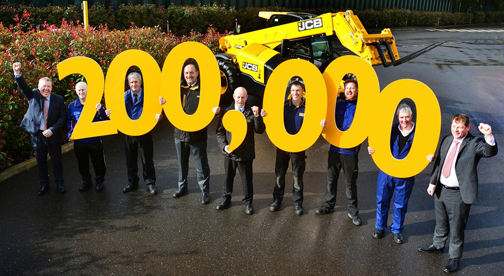JCB Rolls Out 200,000th Loadall
In what the company calls a milestone in materials handling history, JCB celebrated producing its 200,000th Loadall telehandler. The Loadall has provided materials handling and lifting solutions for construction, agricultural and industrial markets for almost four decades.
 |
| Loadall MD Ian Pratt (extreme left) and Loadall Operations Director Paul Grys (extreme right) join employees (l-r) Ian Vickery, Cliff Ferrie, Mick Smith, Dave Bailey, Nick Miller, Paul Stockley and Richard Jenkinson in celebrating the 200,000th Loadall milestone. |
Launched in 1977 as the JCB 520, the first Loadall was a two-wheel drive machine with a 21-ft lift height and a maximum lift capacity of 2.48 tons. Over the past 40 years, the JCB Loadall range has expanded to incorporate machines with working heights of up to 65.6 ft and maximum lift capacities exceeding 6.61 tons.
Updates to the line include introducing four-wheel drive, placing the engine to the side of the chassis to allow a lower boom-mounting position and offering multi-mode steering with equal-sized wheels to improve maneuverability.
JCB completely overhauled the Loadall concept in 1989 with rear-engine models. In 1997 JCB moved the engine to a side-mounted position between the wheels. In 2009, JCB built on existing experience with hydrostatic drives in mid-engine compact handlers to develop the 527-58.
Today, the Loadall engine features a compact exhaust silencer and selective catalytic reduction (SCR) system housed beneath the hood to meet Tier 4 Final emissions standards without the added hardware and servicing costs associated with the diesel particulate filter (DPF) needed on several competitive machines. The 74hp EcoMAX solution meets emissions legislation without any requirement for after-treatment.
In 2014, the company introduced Smart Hydraulics, which includes a unique lift cylinder circuit that permits the boom to lower faster under complete control at low engine revs. This regenerative hydraulics system also added cylinder end-stroke damping, a “bucket shake” feature, automated boom suspension and auxiliary venting. Loading cycles were also 20 percent faster, and the system delivered a 15 percent reduction in fuel consumption.
Last year, the company rolled out its compact Loadall 525-60 HiViz with a hydrostatic transmission, full-sized cab and low boom mounting design to maximize visibility. The machine is just 6 ft high and 6 ft wide.
Since its introduction in 1977, it took almost 30 years for JCB to sell the first 100,000 Loadalls, but it has taken less than 10 years to sell the subsequent 100,000 – a testament to the growing importance of the product and JCB’s strength and dedication in this sector.









